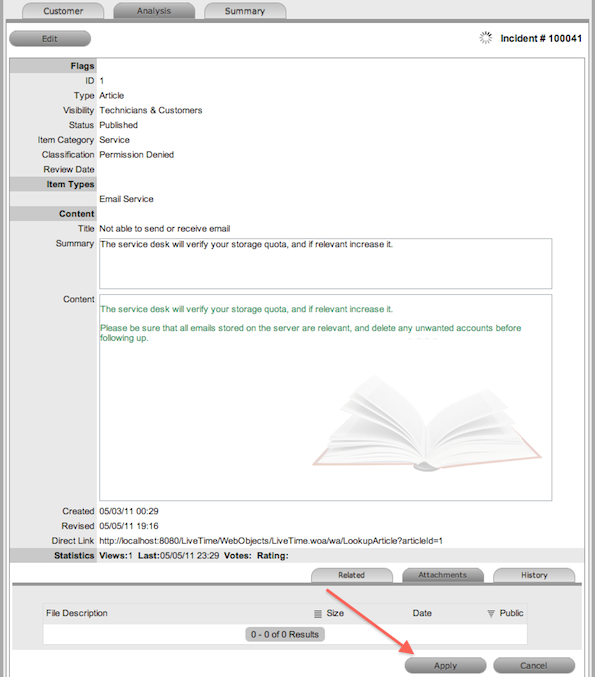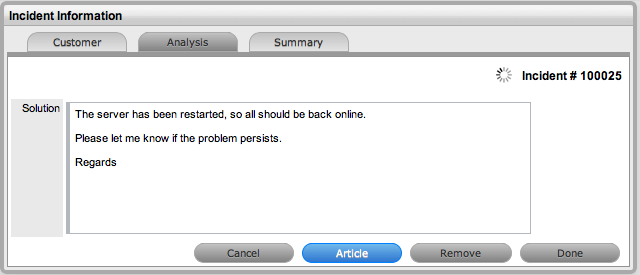Click Edit
The drop-down list will become active.

The Analysis tab is used to search for Solutions, view Alerts or Status Notes and relate the current Incident to other Incidents.
To assign a Solution to the Incident, the User can apply Proposed Solutions presented by the application or use the Search Solution facility. If a Solution Article does not exist, an Incident Solution can be created within this screen. Once a Solution is applied to the Incident, the application automatically closes the Incident.
To search for a Solution:
Click on the number
of the required Incident
The Incident Information screen appears.
Select the Analysis tab
Click Edit
The drop-down list will become active.

Select from the available options, as follows:
Analysis Tab Drop-down Options |
|
Proposed Solution |
Displays a list of all solutions with a search based on Incident Description, Item Type and Classification. To assign a Solution, select the Solution ID number to display the solution in full. Click Resolve if the Solution is relevant. This will close the Incident and update the Customer. |
Search Solution |
Allows Users to enter full text or ID number to search for possible Solution Articles. To assign a Solution, select the Solution ID number to display the Solution in full. Click Resolve if the Solution is relevant. This will close the Incident and update the Customer. |
New Solution |
Displays Knowledge Base editor to allow the User to enter a new Solution. Solution Articles are used as Proposed Solutions for future Incidents. See: Solution Article. |
Link Incidents |
Allows the User to search for related Incidents and group them. |
Similar Incidents |
Displays similar Incidents based on the system searching based on Classification, Item Type and Description. |
Alerts |
Shows details of the Alerts that have been created within the Incident. |
Click Save.
During Incident creation after the Incident Description is completed, the system automatically searches the Knowledge Base for possible Solutions that may be related to the Incident. This search is based on the Item Type, Classification and text matching of existing Articles with the Incident Description content. Proposed Solutions are visible when the Proposed Solution filter is selected within the Analysis tab.
To assign a Proposed Solution to an Incident:
Select the article ID
number.
The system will display the Solution Details screen.

Select ![]() .
.
The Incident is automatically closed or proposed closed, and the selected
article is assigned as the solution.
Within the Analysis tab, Incidents can be linked to other Incidents within a Group.
Link with other Incidents |
|
Link Incident Group |
Allows User to enter full text or ID number to search on Incidents. Select an Incident ID number to immediately link the current Incident to a grouped Incident. |
To link an Incident to a Group within the Analysis tab:
Select Edit
The drop-down list becomes available.
Search for an Incident (Request) or Group using the full text or ID option
Select the relevant
search result ID number.
This automatically adds the current Incident to the existing Group.
To create an Alert that is associated with the Incident, within the Analysis tab:
Select Edit within the Analysis tab
Select the Alerts option in the drop-down
list
The New button is made accessible
Click New
Refine the content for each required field
Alert Details |
Description |
Created |
The current date and time. |
Publish |
The date the Alert is published. Use the calendar icon to the right of the field, to select a Publish date. Set to a date in the future, or use the default to publish the Alert immediately. |
Dismiss |
The date the Alert ceases to be available. Use the calendar icon to the right of the field, to select a Publish date. On this date, the Alert will disappear from a User's Alert list. |
Severity
|
The type of Alert to be published. The choices are:
The icon appearing with the message will depend on the type of Alert. |
User |
The User type to receive the Alert, which include:
|
Title |
Enter the title of the Alert. |
Message |
Enter the main content of the Alert. |
Click Save.
![]()
When a Solution has been applied or proposed for a request with the Create Knowledge option set to No, the Solution is visible within the Analysis tab and not available within the Knowledge Base. To manually escalate a request Solution to a Knowledge Base Solution Article, with the Analysis tab in Edit mode, select the Article tab.

![]()
When a Solution has been applied or proposed for a request, the Solution or Knowledge Base Solution Article is visible within the Analysis tab. To disassociate a Solution from a request, with the Analysis tab in Edit mode, click the Remove button. The Analysis tab will now only display the default drop-down list options.